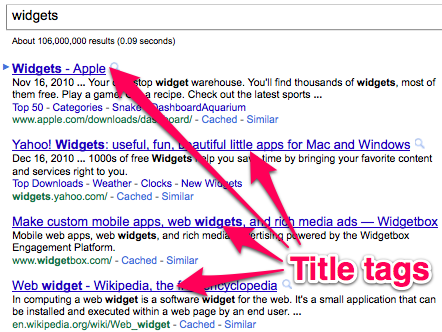In today’s competitive online arena, business owners have to jockey for position in the race for #1 spot on the 1st page the Google search results, and your website Title Tags are a crucial part of helping you win the race!
What are Title Tags?
A title tag is the main text that describes every website, application, or online document. For many years, Title Tag elements have been considered one of the most crucial first steps to proper on-page SEO elements along with solid relevant unique content. Title Tags are also used to convert impressions into click because they appear in three key places online: your internet browsers, Search Engine Result Pages (SERPs) such as Google, external websites that may link back to you including social media platform when sharing pages as posts, and via text message when sharing using smartphones devices.
Why Title Tags are Important for SEO?

- Browser: Title Tags will often show up at the top of web browsers such as Chrome or Firefox window tabs that are open.
- Search Engine Results Pages (SERPs): When you search using keywords and those keywords are within your Title Tag, search engines will often highlight the Title Tags in the search results if a user has performed a query including those keywords. This gives businesses greater visibility and generally means you’ll get a higher click-through rate because the potential customer sees exactly what they’re looking for in bold.
- External Websites: Many external websites such as social media platforms utilize Title Tag as the anchor text when shared.
4 Steps to Optimize Your Title Tags Yourself:
1. Be Mindful of Length
According to current Google standards, the ideal Title Tag length is between 50-60 characters, or 512 pixels wide. According to the general rules, if the title is too long, search engines may truncate Title Tags on SERPs results. You may also see an ellipsis, “…” that show users that the Title Tag has been shortened. However, for news articles, blogs, or press release, longer titles can often work better for driving traffic from social sharing. Some search engines may also utilize the other keywords (from time to time depending on the search engine) in your Title Tag for ranking purposes, even if those keywords get cut off in visual search results. In short, it’s usually better to write a great Title Tag that clearly contains your services and converts into clicks than it is to obsess over length.
2. Place Important Keywords Close to the Front of the Title Tag
We have been performing SEO services for over 10 years, and according to industry testing and experience, the closer the Keyword is to the start of the Title Tag, the more beneficial it can be for keyword ranking purposes and you’re more likely to get the desired clicks when they appear highlighted or bold on SERPs.
3. Leverage Branding
In the majority of cases, we nearly always recommend using the brand name closer towards the end of a Title Tags. However, if the brand name has a strong impact and target market awareness then the strength and awareness of the brand in the target market, or if a brand is well-known enough to make a difference in click-through rates, the brand name should be first. If the brand is less known or relevant than the keyword, the keyword should be first because ranking on your own brand name is usually fairly easy to do.
4. Emotional Impact
Creating a compelling Title Tag that will rank well and will also pull in more visits from the search results is not always easy. In fact, fine-tuning your approach takes years of practice. It’s vital to think about the entire user experience when you’re creating your Title Tags, in addition to optimization and keyword usage. In many cases, the Title Tag can be a new potential customer or visitor’s first interaction with your brand. We recommend that you add a touch of warmth or emotional impact or value building terms such as quality or beautiful. When a potential customer finds you in the search result, it should present your services and convey the most positive message possible.

